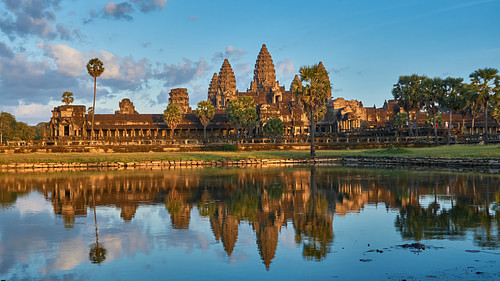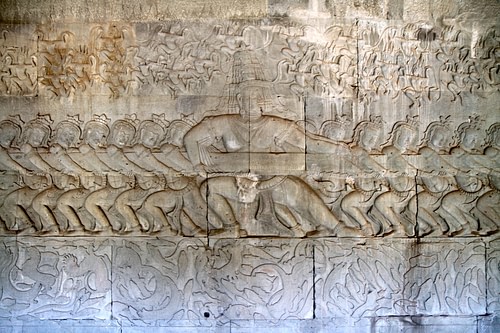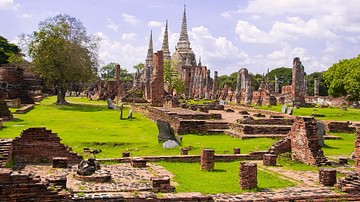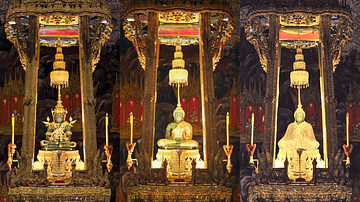
Angkor Wat is a temple complex in the province of Siem Reap, Cambodia originally dedicated to the Hindu god Vishnu in the 12th century CE. It is among the largest religious buildings ever created, second only to the Temple of Karnak at Thebes, Egypt and, some claim, even larger.
Its name means "City of the Temple", and it was created as a physical manifestation of human interaction with the realm of the gods. The spires represent the mountains of eternity and the moat the eternal waters. It was built using 1.5 million cubic meters of sand and silt in the 12th century CE under the reign of the Khmer emperor Suryavarman II (r. 1113-1150 CE) as a grand Hindu temple expressing the monarch's dedication to Vishnu.
The temple covers 420 acres (162.6 hectares) with a central tower 213 feet (65 m) high. The surrounding moat is 650 feet (200 m) wide running a perimeter of over three miles (5 km) with a depth of 13 feet (4 m). Its function as a Hindu temple fell out of use in the late 13th century CE, and it was taken over by Buddhist monks.
In its time, it was the grandest complex in the region, the center of the Khmer Empire, but had been largely abandoned by the 16th century CE and was taken by the surrounding jungle. Western explorers discovered the site in the 19th century CE, cleared the overgrowth, and began restoration efforts. Today it is a UNESCO World Heritage Site and one of the most popular tourist attractions in the world.
Suryavarman II & Construction
Suryavarman II is considered one of the greatest monarchs of the Khmer Empire (802-1431 CE) for his creation of a strong central government that united the land. Suryavarman II also sent numerous military expeditions against the kingdom of Dai Viet in modern-day Vietnam and the neighboring Champa kingdoms, but these were largely unsuccessful. His greatest successes were in diplomacy, not war, as he successfully opened relations with China which increased trade and stimulated the economy.
Although he is remembered as a great ruler, Suryavarman II was a usurper, who assassinated his great uncle Dharanindravarman I (r. 1107-1113 CE) to take the throne. He is said to have compared the coup to destroying a serpent but what this alludes to, or what his motivation was, is unclear. He then legitimized his rule through personal accomplishments and immortalized it through the construction of the grand complex of Angkor Wat, dedicated to his personal protector-god Vishnu, most likely in gratitude for his victory. He had amassed considerable wealth through trade and taxes and spared no expense in the creation of his temple. Scholar Christopher Scarre notes:
The Khmer's unique form of kingship produced, instead of an austere civilization like that of the Indus, a society that carried the cult of wealth, luxury, and divine monarchy to amazing lengths. This cult reached it apogee in the reign of Suryavarman II who built the temple of Angkor Wat. (366)
The building was purposefully situated, and paths created in the jungle, so that visitors could only enter from the west, a direction traditionally associated with the land of the dead but also with Vishnu, to experience spiritual renewal as they drew closer to the divine energies of the temple. The design, and imposing height, was intended to draw the eye upwards to read the great stories of the gods, heroes, and ancestors carved in stone across the walls and up the columns of the great temple. All around the complex, homes and workshops were built, markets and other businesses were opened, and a network of roads created.
A substance known as laterite was formed to support the emerging temple which was then encased in sandstone. The sandstone blocks used in construction were quarried from a site known as the Kulen Hills, 18 miles north, and floated to the construction site through a series of canals. It is unknown how long construction took to complete and, according to some interpretations, it was never fully completed.
Religious Background
Angkor Wat can be interpreted in many different ways but Suryavarman II wanted to ensure that, however one saw the work, he would be part of it. Suryavarman II is depicted in statuary as Vishnu, consorting with the god, and performing his responsibilities as ruler such as reviewing his troops and holding court. The appearance of the monarch's likeness in so many different scenes, in fact, led early excavators to conclude that the site was a funerary temple.
There are compelling reasons to come to this conclusion: unlike the other temples in the area - which face east - Angkor Wat faces west toward the land of the dead. Further, the bas-reliefs which adorn the temple are clearly meant to be read counterclockwise and, in funeral services, one conducts traditional religious rituals in reverse. If any evidence had ever been found of Suryavarman II's burial at the site, there would be no contesting the claim for it as a funerary temple; but there is no evidence of this.
It is possible that it was begun as a funerary temple but it remained unfinished at Suryavarman II's death and he was cremated and buried elsewhere. It is more likely, however, that Suryavarman II had it purposefully built to honor his god, and this claim holds more weight when one considers the king's religious beliefs.
Suryavarman II practiced a form of Hinduism known as Vaishnavism, which is devotion to the god Vishnu above all others. Although Hinduism is generally regarded as a polytheistic religion by westerners, it is actually henotheistic, meaning there is only one god with many different aspects. In a henotheistic belief system, a single god is considered too immense to be grasped by the human mind and so appears in a multiplicity of personalities all of which focus on a single different aspect of human life.
In Hinduism, Brahma is the supreme deity who creates the world while, in his form as Vishnu he preserves life and, as Shiva, takes life away and rewards humans for their toil with death, which then continues the cycle of rebirth or leads to union with the oversoul. Angkor Wat reflects the course of life, death, and eternity according to Vaishnavism, removing Brahma as the supreme god and replacing him with Vishnu.
Vishnu appears to human beings in many forms throughout the centuries as avatars - like the popular Hindu god Krishna - to guide and instruct people. The most famous example of this comes from the religious text Bhagavad-Gita (“Song of God”) when Krishna visits Prince Arjuna on the battlefield of Kurukshetra to explain the nature of existence and one's purpose in life. The temple of Angkor Wat is designed to fulfill this same purpose through its ornamentation which tells the story of the human condition, the immanence of the gods, and how one is to best live one's life.
The rise of Vaishnavism in Cambodia was a direct result of the conflicts between the Khmers and the neighboring Champa. Suryavarman I (r. c. 1006-1050 CE) extended the frontiers of his realm into Thailand during his reign and came into conflict with the cities of the Champa. The Champa's religion was Buddhism (which was also the faith of the Khmer elite) which was viewed with hostility by most Khmer who saw it as a threat to their faith. Vishnu, as a protector-god, rose in popularity through these conflicts and the backlash against Buddhism.
By the time of Suryavarman II's reign, the form of Hinduism known as Brahmanism, which favored the elite, was growing more popular in the region and Buddhism had also gained more adherents. Suryavarman II elevated the position of the common people, using religion, by decreeing the worship of Vishnu, a deity who was a protector of all, not the supreme creator aspect nor the destructive aspect but the mediator between human beings and the divine who had also proven himself a benevolent guardian.
One of the most popular stories of Vishnu's kindness and cleverness in the interests of human beings is The Churning of the Ocean (also known as The Churning of the Ocean of Milk) in which he tricks the demons into surrendering the amrita (ambrosia) which will make the gods immortal and preserve eternal order. This story is among the most famous bas-reliefs found at Angkor Wat and supports the claim that the building was originally conceived of as a temple of worship rather than a funerary site.
Stories in Stone
Angkor Wat is designed to represent Mount Meru, the spiritual and physical nexus in Hinduism which is the center of all reality. The five peaks of Mount Meru are represented by the five spires of the temple. Brahma and the Devas (demigods) were thought to live on Mount Meru and it is famously referenced in The Mahabharata when Yudhishthira and his brothers travel to the gates of heaven. One by one the brothers die until only Yudhishthira and his faithful dog are left. When they reach the border of heaven, the gatekeeper tells Yudhishthira that he may enter for the worthy life he lived but that dogs are not allowed in heaven. Yudhishthira rejects any paradise which does not include dogs and turns away, but the gatekeeper stops him and reveals himself as Vishnu who was only testing him one last time before allowing him entrance.
Stories such as this are told all over the temple where one finds scenes from the classic works of Hindu religious literature such as the Ramayana and Bhagavad-Gita. The great Battle of Kurukshetra from the Gita is depicted clearly as is the Battle of Lanka from the Ramayana. As most people could not read in the 12th century CE, Angkor Wat served as a gigantic book on which the important religious and cultural tales could be related visually.
The temple was galleried – meaning it progresses upwards through a series of galleries - giving ample room for the designers to explore the cultural, religious, and temporal history of the people. The outer gallery of the temple stretches for over 1,960 feet (600 m) covered in these reliefs. Angkor Wat was designed to represent the world with the four corners of the outer wall anchored at the four corners of the earth and the moat representing the surrounding oceans. Scenes from everyday life, mythological tales, religious iconography, and royal processions all wind themselves around the façade.
At the western entrance, a large statue of eight-armed Vishnu has been placed in the present day to receive visitors who place offerings at his feet in supplication or in gratitude for prayers answered. The central sanctuary of the temple is aligned north-south to the axis of the earth, and the Vishnu statue once stood in the center, making clear that Vishnu was at the heart of all earthly and divine occurrences. The galleries, according to some scholars, were used for astronomical observations and were built specifically for that purpose so that astronomers could clearly view the rotation of the heavens in the night sky. There is no doubt the site was linked to astronomical observances as it is precisely positioned to mirror the constellation of Draco, the dragon, which represents eternity because it never sets.
Transformation & Decay
Angkor Wat was rededicated as a Buddhist temple in the 14th century CE and statues of the Buddha and Buddha-related stories were added to the already impressive iconography. As the Buddhists respected the beliefs of the Hindus who still worshipped there, all of the original statuary and artwork was left in place. The Buddhist craftsmen added to the intricate story of the temple while taking nothing away.
By the early 16th century CE, use of the temple had waned, even though it was still occupied by Buddhist monks, and it became the subject of stories and legends. It was said to have been built by the gods in the distant past and a popular story emerged that the god Indra had built it as a palace for his son and that it rose from nothing in the course of a single night. The temple was protected from the surrounding jungle by the immense moat and so, unlike other ancient temples and cities (such as those of the Maya of Mesoamerica) it was never completely lost.
Even though local people still visited the site, it became increasingly associated with hauntings and dark spirits. The great enthusiasm of devotees who used to visit the temple, it was said, needed to be continued to infuse the area with positive energy. Once worship at the site fell off, the dark spirits, attracted by the afterglow of the high energy, moved in and made the place their home. Dark energy was now thought to emanate from the empty galleries, porches, and entranceways, and fewer and fewer people went to visit. With only a few monks to care for it, the buildings began to decay and even though it was never completely taken by the jungle, natural growth made headway up the walls and through the cracks between the stones.
Western Discovery & Restoration
The temple did not sit quietly for long, however. In western documents, Angkor Wat was first visited by the Portuguese monk Antonio da Madalena in 1586 CE whose notes on the complex clearly convey his sense of wonder. He made no efforts at restoring the site, or even suggesting it, but recorded its location. The next westerner to visit was the French archaeologist Henri Mouhot c. 1860 CE. Mouhot is always cited as the man who "discovered" Angkor Wat but, actually, it was never lost. Anyone who lived in the area knew of the site, and it was known in legend by people far off.
Mouhot was, however, the first westerner to take an active interest in Angkor Wat and publicize its existence. He was so impressed by the temple that he devoted himself to its renovation and restoration. Mouhot believed the temple had been built by some ancient civilization now lost and considered the stories of how Indra had raised the structure in a night to be evidence of an ancient culture's lost technology. He refused to accept that it could have been built by the ancestors of the Cambodians he interacted with on a daily basis in exactly the same way that westerners c. 1850 CE rejected the notion that the great cities and temples of Mexico and Central America could have been built by the Maya.
Since Mouhot's time, Angkor Wat has become world-famous. Millions of people visit the site every year and restoration projects are ongoing. In 1992 CE, UNESCO declared it a World Heritage Site and, even though it was not chosen as one of the New Seven Wonders of the World, it was a finalist in 2007 CE, which garnered even greater attention for the site.
In 2016 CE, a New York Times article reported on the ongoing efforts of archaeologists who continue to make discoveries in the surrounding jungle and have located the sites of the workers who built the temple and of others who lived around the complex. The temple itself has undergone major restoration and is one of the most popular archaeological parks in the world. Those who visit Angkor Wat today are following in the footsteps of literally millions of people from the past who have emerged from the surrounding jungle to find themselves at the site Suryavarman II created as the nexus of earth and heaven.








